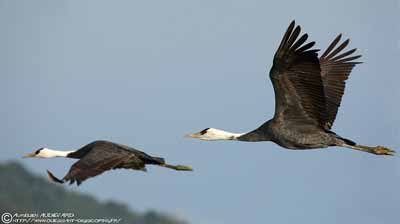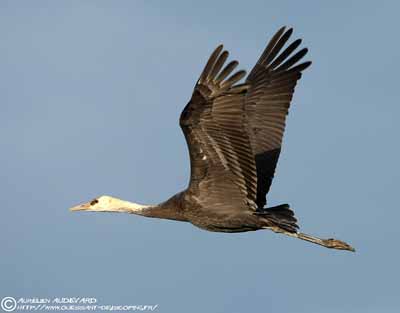PROTECTION / THREATS / STATUS:
The Hooded Crane is threatened by habitat loss with drainage of wetlands and dam-building. Ricefields disappear little by little, converted into cotton fields. Pollution by pesticides and human disturbances are also important threats.
The high concentration of cranes at feeding-stations involves the risk of disease. In addition, this species has very restricted range.
However, there are protected areas and several suitable wintering sites are expanding.
Several captive breeding programs are on their way in zoos.
This species is listed as Vulnerable.
Fr: Grue moine
All: Mönchskranich
Esp: Grulla Monje
Ital: Gru monaca
Nd: Monnikskraanvogel
Sd: Munktrana
Jap : Nabeduru - ナベヅル
Photographer:
Aurélien Audevard
OUESSANT DIGISCOPING
Text by Nicole Bouglouan
Sources:
HANDBOOK OF THE BIRDS OF THE WORLD Volume 3 by Josep del Hoyo-Andrew Elliott-Jordi Sargatal - Lynx Edicions - ISBN : 8487334202
BirdLife International (BirdLife International)
XENO-CANTO – Sharing Birds sounds from around the world
Hooded Crane
Grus monacha
Gruiforme Order – Gruidae Family
BIOMETRICS:
Height-length: 100 cm
Wingspan: 160-180 cm
Weight: M: 3280-4870 g - F: 3400-3740 g
DESCRIPTION:
The Hooded Crane is bulkier than other cranes. This bird is listed as Vulnerable species, due to its restricted range and several threats.
Adult has slate-grey body. Flight feathers and tail are black.
Head and upper neck are white. The bare forecrown is red with black hair like bristles around the bare patch.
The long, straight bill is pale pink. Eyes are orange to red. Legs and feet are dark grey.
Both sexes are similar in plumage, but the male is larger than the female.
The juvenile is browner than adults. Its crown is black and white and feathered during the first year. Eyes are duller, rather pale brown than red.
VOICE:
The Hooded Crane utters loud, high-pitched calls as all the races of the genus “grus”.
During the courtship displays, we can hear penetrating calls and duets between mates. The male initiates the display with only one call, while the female utters two or three calls.
HABITAT:
The Hooded Crane breeds in isolated bogs and forested wetlands at higher altitude.
The non-breeding birds frequent open wetlands, cultivated areas and grasslands. During the winter, they are seen on river and lake shores, in ricefields, cultivated areas and grassy marshes, but also in coastal marshes and fields.
During the migration and dispersion after the breeding season, they also frequent wooded and open steppes.
RANGE:
The Hooded Crane breeds in SE Russia and N China.
Wintering areas are in S Japan, South Korea and C & E China.
BEHAVIOUR:
The Hooded Crane feeds on insects and amphibians, but also on aquatic plants such as rhizomes, seeds and grains, rice and cereals, and also artificial food at feeding-stations.
The crane digs and picks food off ground by using the long bill to find invertebrates and plant matter in the soil.
Most species of cranes take advantage from the food sources provided by the cultivated fields. They feed in large flocks while calling. Several birds are looking around for predators or intruders while the flock is feeding.
The Hooded Cranes are monogamous and both mates stay together all year round, and usually pair for life.
The territory is established very soon after they arrived at the breeding grounds, and the pair defends it using calls and threat displays.
They perform several courtship displays including “unison-calls” and duets between mates. We can see several types of displays such as dances with bowing, jumping, running and wing-flapping. The bird also tosses some plant items into the air.
Other posture shows the bird standing up with head thrown back and bill upwards. The male also raises the wings during the “unison-call”.
The intensity of the wing-posturing depends on the aggressivity associated with the displays.
The Hooded Crane is migratory and leaves the breeding grounds until the next spring. They migrate in large flocks while using contact calls.
FLIGHT:
The Hooded Crane has to run into the wind to take flight, and then, it quickly gains speed and lifts into the air by pushing with the large wings.
Cranes fly with head and neck stretched forwards.
In flight, they are very elegant and perform steady wing-beats. It alights in standing stance, after descending with fully spread wings and tail.

REPRODUCTION:
The Hooded Crane breeds in spring.
The nest-site is situated in bog with scattered larch trees. Both adults build the nest with moss, branches and sedge stalks and leaves, found in the area.
Female usually lays two eggs and both parents incubate during about one month (27 to 30 days). The chicks have dark brown down above and paler below. They are fed by both adults at nest, but the chicks can eventually follow the parents to the nearby feeding areas. Parents feed them until they are several months old.
The young fledge 75 days after hatching and the family leaves the breeding grounds by August. They remain in family group until the next breeding season. They are sexually mature at 3-4 years.
DIET:
The Hooded Crane feeds on plant matter such as berries, roots, seeds and grass. It also catches insects and worms, frogs and other amphibians.
They receive artificial food during winter at feeding-stations in Japan, and feed on cereal grains.
